How do you usually think about growing your SEO agency?
A common way of doing things, at the beginning of founding an SEO agency, may look like this:
The founder has lots of energy and shares her SEO expertise with the first clients to come. They are satisfied with her performance and trust the value of their SEO campaigns. As they start referring the agency to their networks, growth happens organically. For a while, the only way is up.
Until one day, when the internal landscape of her SEO agency starts shifting. The client portfolio diversifies, so the founder has to tackle both client management, and hiring and managing a team to deliver, at least, the same SEO performance, if not better. There’s also business development to consider.
This is the moment when clients start leaving.
Maybe they don’t have enough resources anymore, maybe they’re not convinced about their SEO results, or maybe they’re not that suited for the agency’s SEO efforts, to begin with.
For instance, a startup trying to validate their business idea or market segments: they won’t have the necessary time or budget to invest in long-term SEO strategies and get the real value of such efforts.
There are various motives for a client leaving, some of which are in our founder’s control and some which are not.
But, one burning question remains:
What happens when good clients decide to leave for a competitor?
As the business becomes more sophisticated, the challenge of growing the SEO agency translates into staying on top of two major components, among other things:
- The client acquisition process.
- The client retention process.
If the client acquisition process cannot be scaled in a fast way – because you need to have your best consultants doing the SEO proposals followed by the pitch, and they have limited time in a day – you can decide to focus on your client retention and improve that to unlock your agency growth.
Furthermore, when we consider the type of growth that happens for a subscription-based business model, improving client retention can also mean lower costs of re-acquisition and maintenance, and even overcoming the plateau effect, which an agency may reach at certain steps of its development.
Over time, improving the retention rate translates to efficiency in terms of resources invested and revenue per month, along with a higher cash flow predictability, as higher retention (compound revenue) can outgrow a higher acquisition rate.
But, you probably know the already old business adage: you can’t control what you don’t measure.
It’s like driving a car with a broken speedometer. You have no idea how fast you’re driving as you enter a speed limit section. You may feel like you’re in the right parameters or, perhaps, you’ll lose your driver’s license.
Both scenarios are possible, and you have no objective way of knowing.
So, the first order of business you can tackle: measuring client retention.
You may start thinking about the agency’s churn rate, meaning the percentage of clients leaving in any given month and how to go about optimizing that percentage.
After all, what’s behind the churn rate is a whole ecosystem that you need to keep track of, ideally in one place: client profile, SEO performance trend, client engagement, and communications, goals or transactions, etc.
What happens when good clients decide to leave for a competitor?
How Would Walmart Measure Your SEO Agency?
As you consider all those metrics, and how to define and organize them to fit your SEO agency, let’s take a step back and remember Walmart.
We’re back in the early 1990s when one still has to manually calculate stocks to make a profit and outrun the competition. Again, it’s a pressing matter of growth and scaling.
If you’re like any of the giant retailers, that’s how your data analysis process probably goes: every evening, daily point-of-sale transactions are batched up and sent to a regional hub. After a few days, someone at the regional hub adds the sales up, from multiple stores. After a week or so, these results get at the head office, where a manager calculates new stocks and decides the next bulk purchase for shampoos and detergents, let’s say.
Just the usual order of business.
Until that moment when one of your competitors decides to change the process.
Enter Walmart.
They launch a geostationary satellite that lets them track inventory for all their stores in real-time. They know what to keep stocking every day, across the country. Your week or so decision making isn’t good enough anymore, as they continuously outperform you by 15%.
Not only a tale of disruption (see more in Salim Ismail’s Exponential Organizations), Walmart’s case is an example of having accurate real-time metrics for immediate action, organized in an actionable dashboard.

Returning to your SEO agency, as you keep on outlining your business processes and understanding your current growth patterns, you’ll manage to pinpoint the types of data you need to know and measure.
Without the right metrics to look at and objectives to “translate” your status, resources, and trends against, you can get sidetracked. It’s only human, after all.
Or, to continue our car analogy, you’ll fix your speedometer, and you’ll see 50 miles on your dashboard. You just solved one issue.
But there’s a catch. The speed limit in the country you’re in is shown in kilometers and you’re currently driving with 30 kilometers above that limit.
How to Develop Your SEO Agency Operational Dashboard
To be like Walmart and scale your SEO agency with speed and efficiency, you should take into account:
- What the daily tasks that need fast reactions and real-time data are.
- What historical trends you need to be aware of to make data-driven decisions.
Another thing to keep in mind: not every metric is actionable or critical. Also, not every metric is essential if it distracts you from your business strategy in the first place.
The challenge is to calibrate the delicate balance between objectives, metrics, and results that translate in managing resources, processes and profit margins within set growth limits.
You can start with the fundamentals:
1. Your SEO Agency Business Model
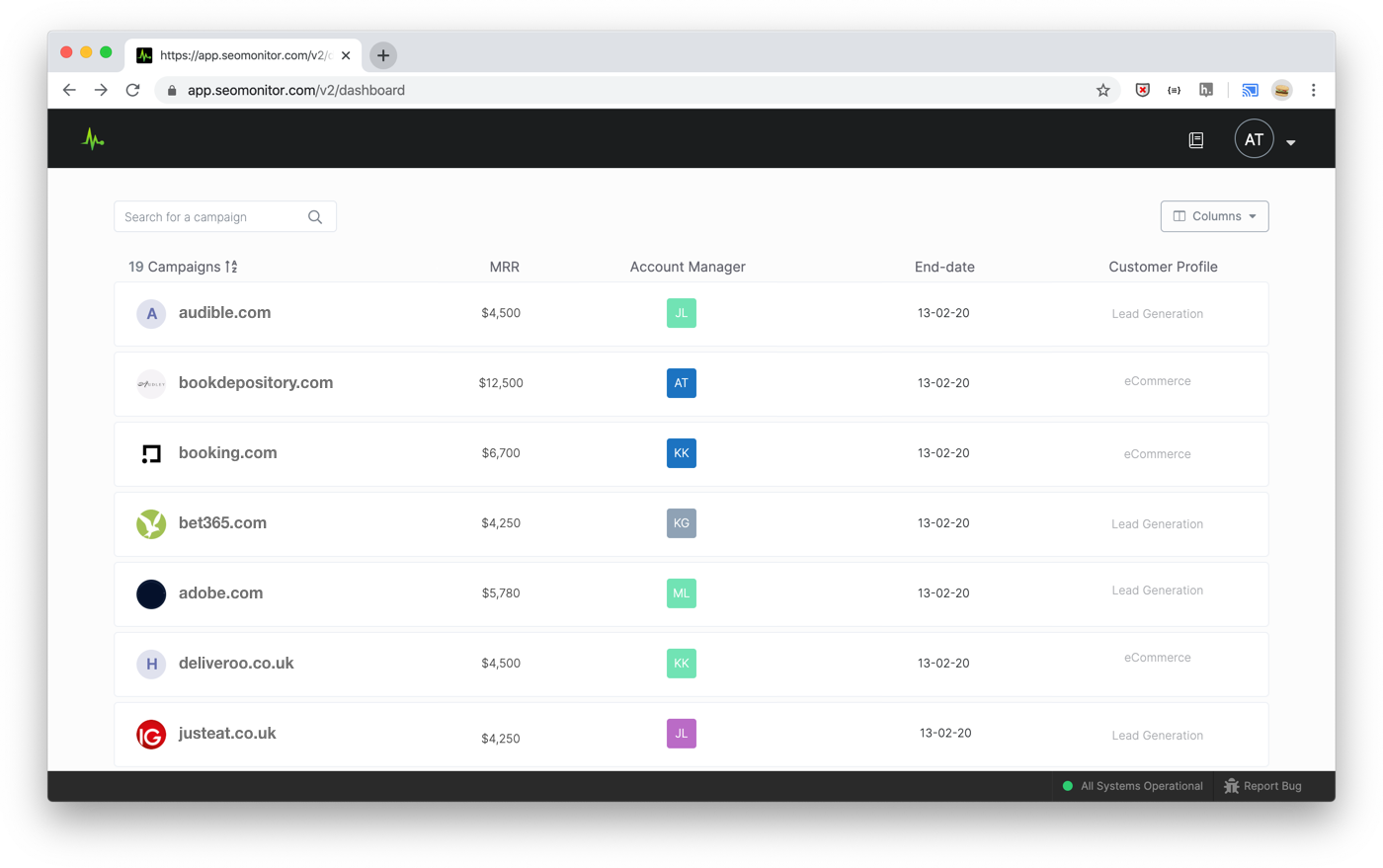
Think about:
- The types of contracts that you sign with your clients.
- Their lifetime value.
- How you keep track of every single one.
That is how you can start analyzing the forces impacting your churn and better understand how your agency portfolio trends look like.
You may define the following parameters to include for each client subscription and get an even deeper understanding of your agency landscape:
- Contract type.
- Start date.
- End date.
- Monthly recurring revenue (MRR).
- Client profile.
- Account manager.
You can also include the average revenue per account (ARPA) metric to have a clear picture of where you’re standing in terms of business revenue, as it highlights your growth trends.
Make sure not to include one-time clients and special projects when calculating MRR, or you’ll lose revenue accuracy.
In the end, you can also correlate these parameters with new business metrics like new qualified leads or new monthly clients, for instance, to further optimize your overall strategy.
2. Current Visibility of Your Clients
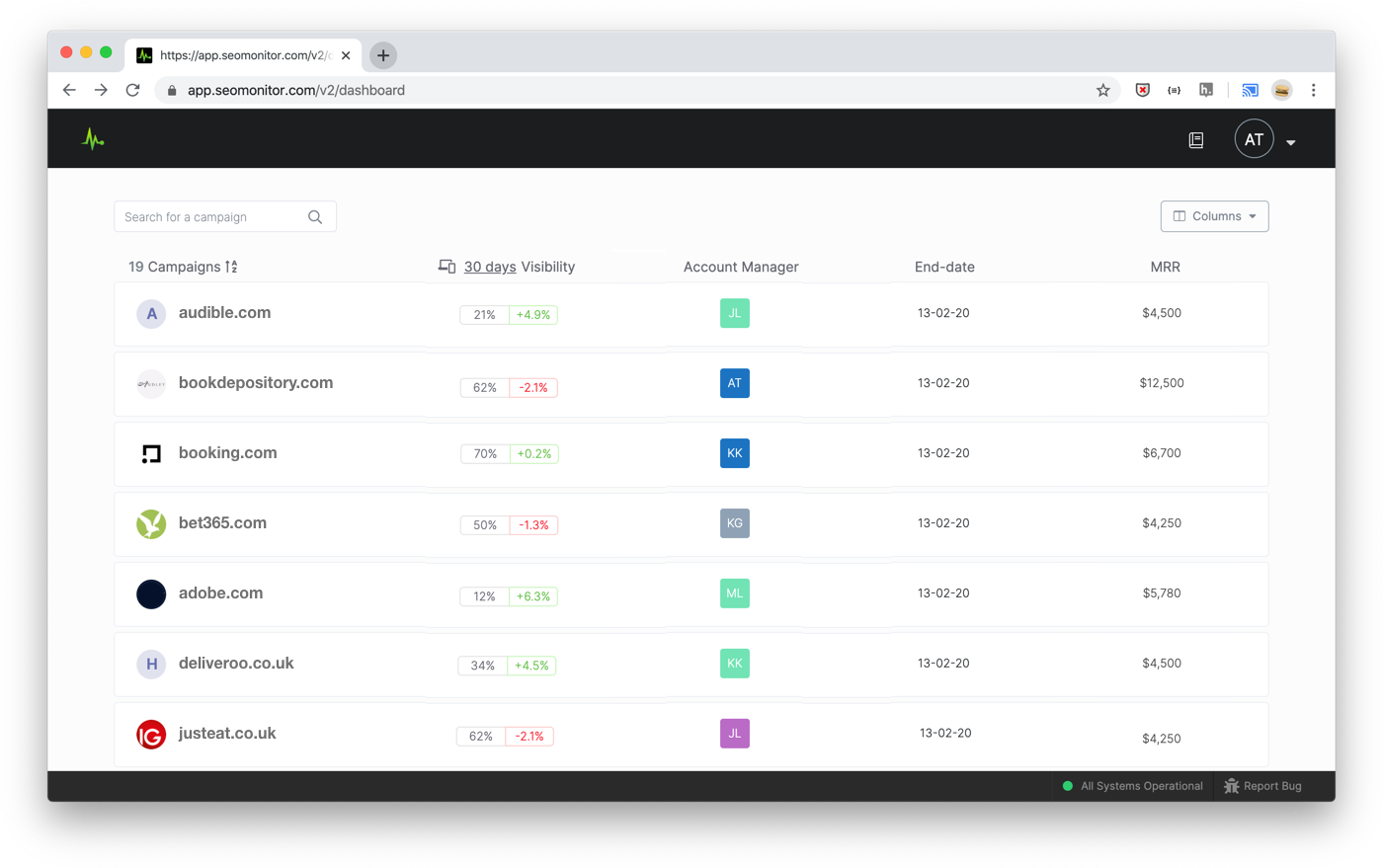
Then, another key metric to closely watch, that underlines the state of your SEO campaigns and your performance as an SEO agency is the visibility score.
You can think of visibility in terms of impression shares, for instance: taking into consideration the ranks of your keywords and their monthly search volumes, so you’ll be able to prove your SEO value in correlation to a client’s business objectives.
To have a complete picture, you may want to measure visibility trends (daily, weekly and monthly).
You’ll be able to better evaluate when the clients are happy and when they’re not, and think about strategies to raise your SEO impact.
Also, you’ll be able to compare visibility scores with the health of an account, the allocated resources, and the type of client, to get a deeper understanding of your current portfolio. And how you can further grow it.
3. The Health of Your Accounts
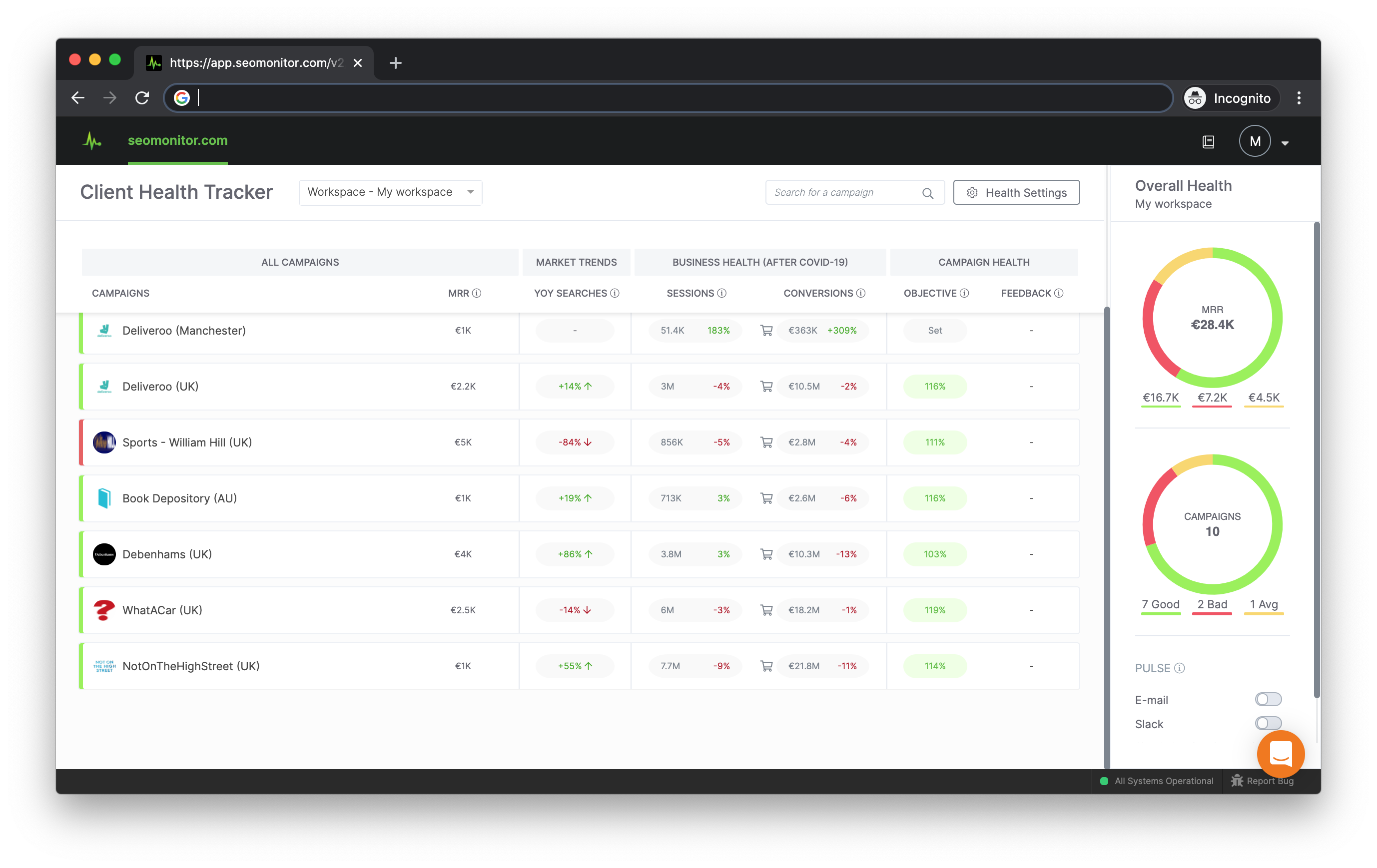
After looking at the visibility score, you can take into consideration the status of every account in your current portfolio. You can define that as the health of accounts and assign it as a percentage or score.
It may be the goal set at the beginning of your SEO campaign (forecast) versus its current status, or it may be a client engagement or client feedback score.
Whatever makes sense for your SEO agency to define as client health, it can be an efficient way to spot what accounts are on track, what accounts are in danger of getting behind, and easily address the ones that are already behind and need fast action.
A color-coded system might be useful in that regard.
You can also think about setting alerts when a certain percentage or score needs immediate attention.
No more satisfied clients on paper only!
4. Budgets & Allocated Resources per Client
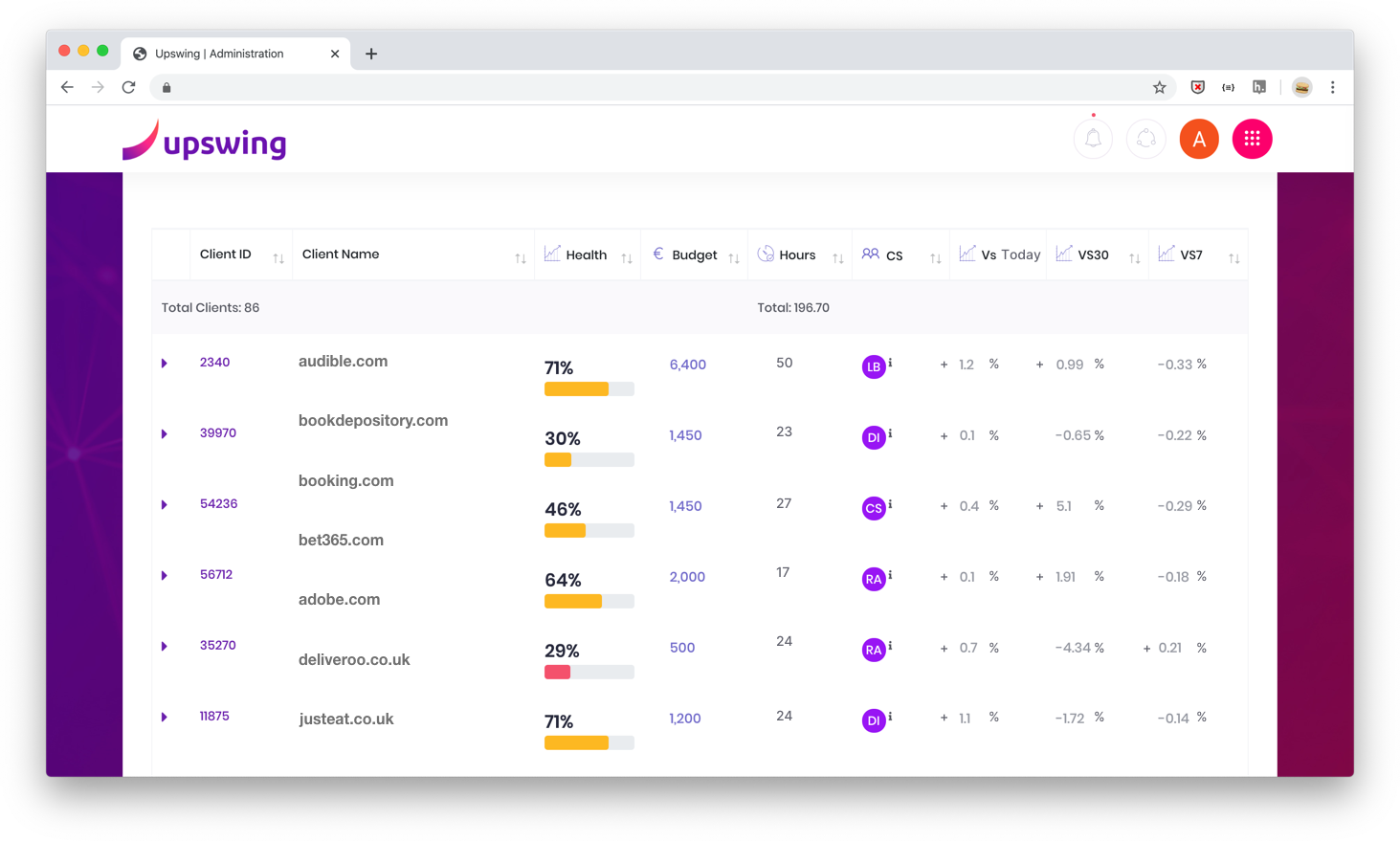
Managing your clients with efficiency also means understanding where your focus is in a given timeframe.
Being able to pinpoint where you allocate more resources in a month or if you went past a client’s negotiated budget can support you in optimizing internal processes.
That’s why an overview of budgets and human resources allocated per campaign, together with the campaign’s daily or weekly health status, can help you better prioritize and manage your clients.
You will be able to compare resources with client type, current status, and even historical status (weekly, monthly, or quarterly).
This comparison will give you an accurate overview of where and how you spend your resources and what needs to be changed or further defined to lower the churn rate.
After all the groundwork is done, you’ll have a good foundation for your internal dashboard that you can test and iterate, so it’s truly actionable and answers your business questions.
As your agency continues to change and evolve, so do your metrics. Remember that the operational dashboard is a part of a larger process, so make it a “living organism” as well. Adapt it to your changing needs, and keep in mind what you should measure and how it correlates with your growth objectives.
It’s not like a car’s dashboard in 2020 is the same as the one that the 1937-Chrysler model had.
As the driving conditions become more sophisticated, so do our measurements and need to control more functions of our cars.
Making Dashboards Actionable & Adopting Them Across the Agency
Now that you’ve developed the operational dashboard with all the relevant KPIs, which your whole team has access to, you need to make sure they use it. At this point, you probably had multiple conversations with your account managers and SEO specialists, and know their specific requirements, as well.
As mentioned before, your team needs real-time tactical data so that they can act with efficiency. You also need historical data to track trends and understand where your SEO business is heading.
Consider driving once more: you must track speed, fuel, rpm and so on to know when to slow down, when to stop at a gas station and when to change gears at any given moment.
But you need to know the mileage of your car, so you assess its yearly health.
The Operational Dashboard Should Cater to Every SEO Agency Role
Your operational dashboard can help your account management with their daily status check and what clients to prioritize or report to. It can support your SEO specialists see the number or percentage of campaigns that have a drop in health, so they instantly react.
For instance, if a batch of clients appears to be reaching the end of their contract period, your Customer Success team will know it’s time to set new meetings and start creating SEO proposals for extending the collaboration and keeping the retention steady.
Or, maybe, you have a big account that has health issues, and your technical specialist can immediately investigate.
You’ll manage to stay on top of your portfolio and inform clients of changes before they get to call you.
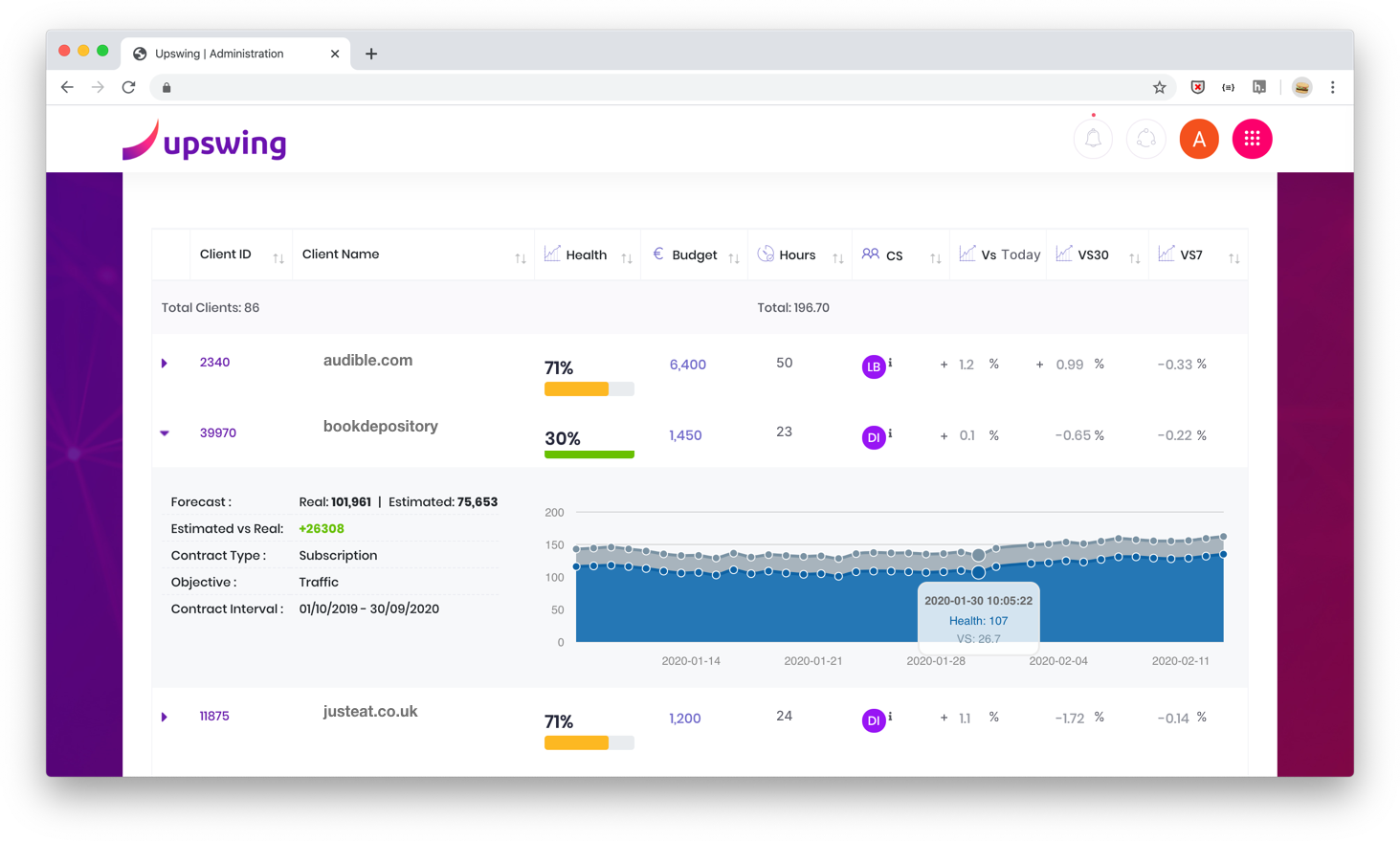
Moreover, it can be the case that you want to analyze trends related to your monthly recurring revenues and client subscriptions. You’ll be able to adjust the sales strategy or look at negative trends that impact your resources.
Whatever the case, every role in your SEO agency can be catered to with this internal dashboard, so that they can do their job with more efficiency.
The Operational Dashboard Should Improve Your SEO Agencies Processes
It’s all about understanding the relevant story behind your data, in real-time, and across the agency. To make the internal dashboard usable, you should think about the specific moments you need a particular type of insight.
- Is it daily for technical issues?
- Is it monthly for client reporting or, maybe, to check the MRR and ARPA status?
- Do you need custom time frames for visibility?
- Do you need to see the weekly clients’ health and the status of your CS team?
Think about how you get this kind of data now.
Maybe you have known unknowns in your current tools, and you keep postponing a dashboard optimization. Or perhaps you have various excel files with tens of tabs each.
Your operational dashboard should help you understand where’s room to grow, what are your current bottlenecks and what are the trends in aspects like new clients, churned clients, MRR on track or behind, visibility trends, client engagement and so on.
It may seem like another thing to add to your workload, but if it’s a simple and easy to comprehend dashboard, that you can interact with, you will gain valuable time for quick actions and decisions.
It will help with team communication as well, as you’ll all have the same version of the truth to check and return to regularly. With a process in place, your departments’ workflows will be better defined, and they’ll know when to draw attention to specific issues, without you having to intervene at every step.
You’ll be in control of your business processes, while the “car drives itself” under your careful watch.
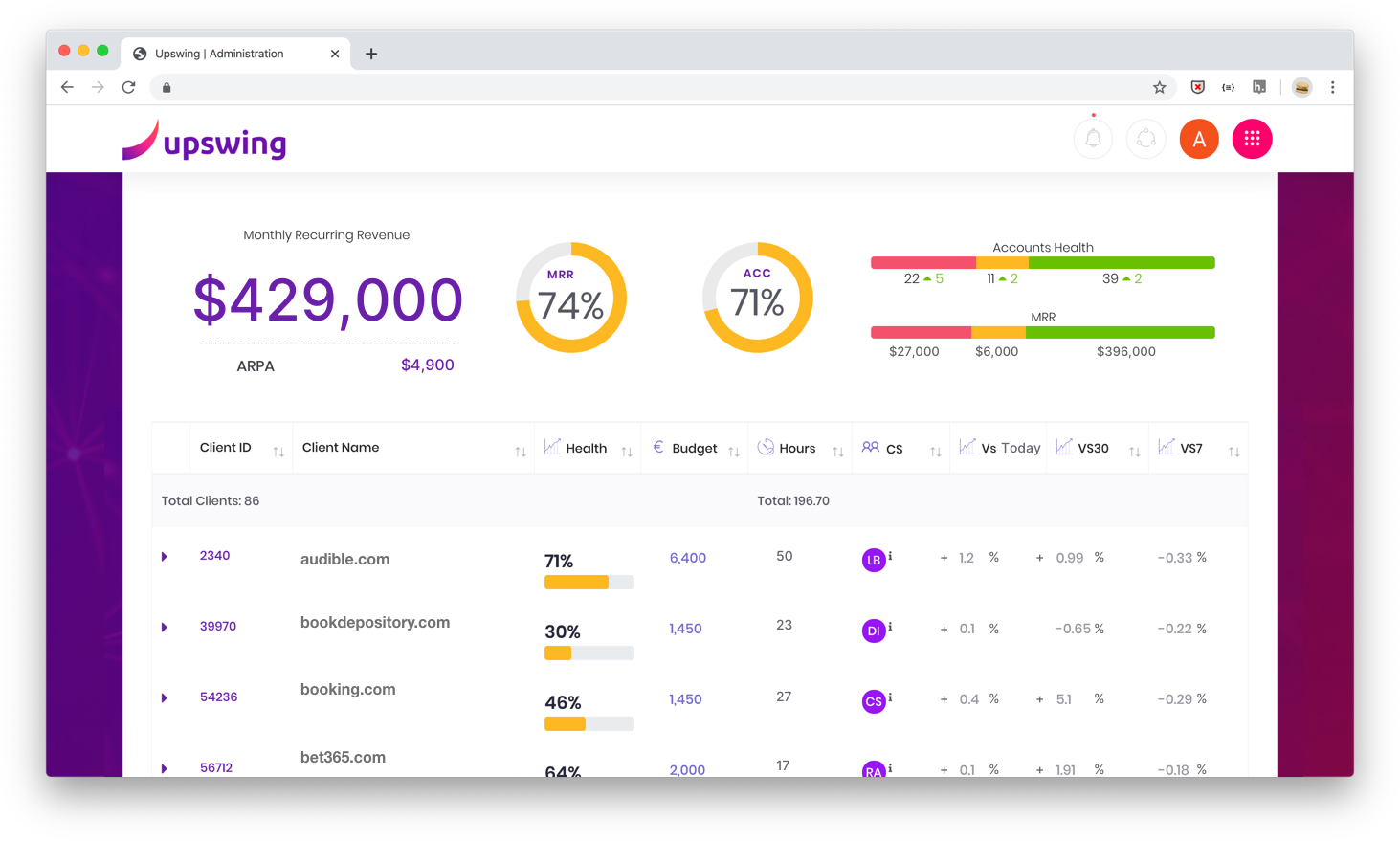
Summary
Stop for a moment and think about the insights you need from an internal dashboard for your SEO agency to unlock healthy growth:
- Consider your SEO agency business model and how each contract type correlates with your monthly recurring revenue (MRR) and churn rate.
- Think about the metrics that matter: The number of leads, health of accounts, allocated resources (budget, staff hours), the visibility of every campaign – they all influence each other.
- Consider each role in your team and how they can use the operational dashboard for daily efficiency.
- Look at the process behind the dashboard: Do you have relevant, real-time data to make business decisions related to your client portfolio and strategy? Is it an accurate overview?
We know deciding on what to include and what to leave out of an operational dashboard is a struggle.
That’s why we consulted with SEO agencies and designed a dashboard solution that we call Client Health Tracker.
You’ll be able to use our Data Studio connector and integrate non-brand organic traffic stats, competition insights, specific keyword groups performance, and forecasted data in your operational dashboard.
The dashboard that we developed is part of our SEO agency solutions, designed to help you acquire, manage, and retain more customers.
Join us, and hundreds of SEO agencies clients, in the journey of bringing more transparency and measurability to the SEO industry.
Click here for a trial that doesn’t ask you for a credit card, but gives you full access to the platform.
Start building your
SEO agency operational dashboard today
The opinions expressed in this article are the sponsor's own.




